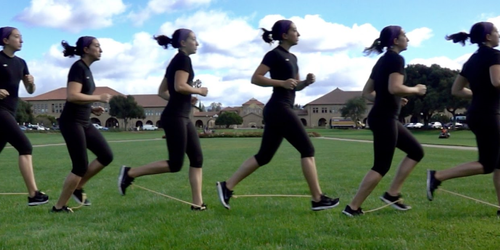
Like Nasiri’s device, the strap from Simpson and his colleagues is essentially a spring connecting the legs. “It’s really like tying your shoelaces together but making them elastic,” Selinger says. That might sound like a recipe for disaster, but the volunteers who tried on the “exotendon,” as it is called, got used to it quickly. “It makes your legs feel light and fast,” says Hawkes, who worked on the project with Simpson and Selinger. “It is pretty fun.”
The exotendon produced a reduction of around 6% in energy costs during running. The efficiency improvement surprised the researchers, as leg-swinging is estimated to account for only a small fraction of energy expenditure, compared to the large energy cost of pushing off the ground and landing. However, the team showed that exotendon users were able to unlock energy savings by adapting their running motion.
The runners’ main adjustment was to increase their stride frequency by about 8%. Faster leg-swinging usually costs more energy, as the leg-pendulum system is driven at a frequency higher than its natural swing frequency of around 100 steps per minute. But the exotendon increases the natural frequency so that faster leg-swinging is less of an energy drain. Moreover, a faster stride is accomplished by reducing the height of each mini-jump involved in running, which cuts energy consumption.
Exotendon users were able to automatically adjust their strides based on these complex energy tradeoffs. It’s as though the runner’s body was saying, “okay, swinging the legs is now cheaper for me, so I’m actually going to swing my legs faster,” Selinger explains.
C. Simpson and C. Welker/Stanford University
To better understand the role of user adaptation, many biomechanics researchers are using human-in-the-loop optimization, in which human subjects wear a tunable device—one that lets researchers adjust the applied forces and torques and monitor the subject’s response. “In real time you are tuning and adapting the parameters of the device the person is wearing to try and lower costs,” Selinger says.
In a report last year, Collins’ team used this approach to explore how an ankle device could improve running efficiency. Runners wore the exoskeleton on a treadmill, while computer programs varied the force inputs. They uncovered a series of force inputs that gave energy savings of 15%. The trouble is that the device was not passive—it required a connection to a power supply. Several groups are developing active exoskeletons that are powered by a portable battery [11], but the extra weight lowers the energy savings, Braun says.
Collins and his colleagues did consider a spring-powered ankle device—similar to the one they used for walking—but the energy savings for runners was only 2%. “We aren’t really sure why the percent change was smaller than for walking,” Collins says. “There are lots of reasons to expect a passive device might be more effective during running, given the spring-like behavior of the leg. But people are complicated.”
"machine" - Google News
June 26, 2021 at 02:03AM
https://ift.tt/3A3gX30
Physics - Improving the Human Machine - Physics
"machine" - Google News
https://ift.tt/2VUJ7uS
https://ift.tt/2SvsFPt
Bagikan Berita Ini














0 Response to "Physics - Improving the Human Machine - Physics"
Post a Comment